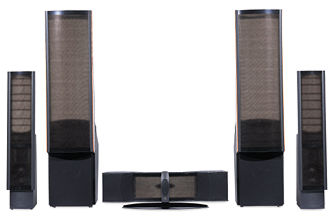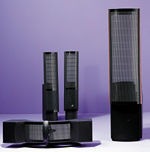MartinLogan Prodigy Speaker System
A core tenet of stellar home theater reproduction calls for a system's ability to re-create infrasonic bass—the kind that drops so low that you no longer hear it, but you can feel it throughout the length of your alimentary canal. The kind of bass that threatens to shatter your gallstones. Of course, getting this kind of gut-whomping bass is relatively easy today, depending on your room's resonance nodes and the amount of greenbacks you can muster for the purchase of a foundation-rattling subwoofer.

Without question, LFE is crucial to home theater, but truly first-rate home theater reproduction has equally to do with the clarity, immediacy, air, and palpability of everything stretching from the upper-bass frequencies through the highest octaves. When I hear glass shattering, for example, I want it to sound like glass, not Alka-Seltzer fizz. As crucial as special-effects displays are to home theater, if you can't catch the emotion of the music, the nuances of vocal timbre between characters, and the subtle interplay of microsounds and macrosounds that involve you in a film's essence, well, you may be watching a movie but may not entirely be getting its soul...which brings us to the unique home theater speaker system under review: the Prodigy left and right, Theater center, and Scenario surrounds—all from MartinLogan, arguably one of the world's foremost leaders in electrostatic speakers, especially hybrids (more on that later).
Among those who can afford them and the powerful amplifiers necessary to drive them optimally (in excess of 200 watts per channel), electrostatic speakers have traditionally had a cult following (at least among the two-channel crowd). The hallmarks of 'stats include stunning transparency, gobs of air, lightning transient response, and phenomenal staging (both left to right and front to back)—all coupled with nearly nonexistent listener fatigue. Most multidriver speakers of the cone variety rely on allocating portions of the audio band to various drivers (generally low, mid, and high) via a crossover network employing, at its most basic, assorted capacitors and chokes.
 One of the concerns among designers of full-range multiple-driver systems has been to create a seamless transition of frequencies between the various drivers. This is no easy task, requiring significant technical expertise, a near-perfect ear, and the patience of Job (you can bet DiGels are part of the serious designer's tool kit). To this end, a number of cone-type speaker systems exist that do the job exquisitely. In effect, the efforts of top-notch designers have largely smoothed over, quite artfully, the inherent phase anomalies of such cone designs, although whether or not these have been eliminated altogether is another matter.
One of the concerns among designers of full-range multiple-driver systems has been to create a seamless transition of frequencies between the various drivers. This is no easy task, requiring significant technical expertise, a near-perfect ear, and the patience of Job (you can bet DiGels are part of the serious designer's tool kit). To this end, a number of cone-type speaker systems exist that do the job exquisitely. In effect, the efforts of top-notch designers have largely smoothed over, quite artfully, the inherent phase anomalies of such cone designs, although whether or not these have been eliminated altogether is another matter.
Electrostatic speakers, on the other hand, resolve crossover concerns—particularly in what MartinLogan calls the "critical zone," the area spanning from 500 hertz to 20 kilohertz where the very soul of sound resides. Because pure electrostatics are crossoverless designs, relying on large, high-voltage/low-current charged flatpanels to create dipole sound, they generate all frequencies in the critical zone in ideal phase relationships to one another.
- Log in or register to post comments




































































